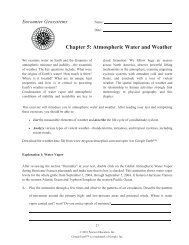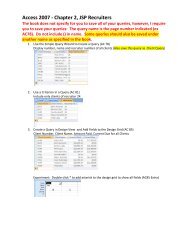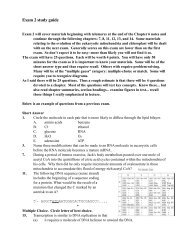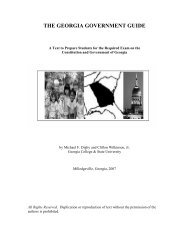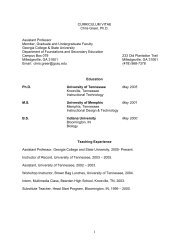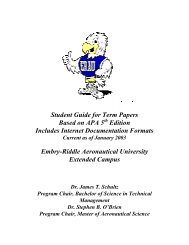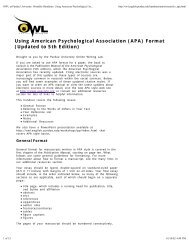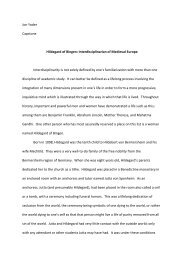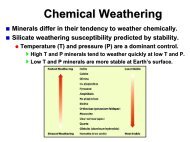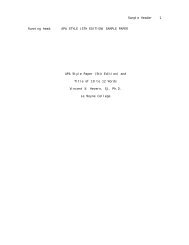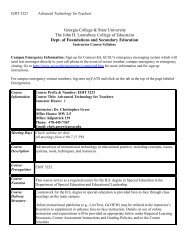Lecture 3
Lecture 3
Lecture 3
- No tags were found...
Create successful ePaper yourself
Turn your PDF publications into a flip-book with our unique Google optimized e-Paper software.
The many functions of soil can be grouped into five crucial ecological roles.
This wet, shallow soil failed to allow sufficiently deep roots to develop to prevent this tree from blowing overwhen snow-laden branches made it top-heavy during a winter storm. (Photo courtesy of R. Weil)
The soil is home to a wide variety of organisms, both relatively large and very small. Here, a relatively largepredator, a centipede (shown at about actual size), hunts for its next meal—which is likely to be one of themany smaller animals that feed on dead plant debris. (Photo courtesy of R. Weil)
Better knowledge of the soils on which this road was built may have allowed its engineers to develop a morestable design, thus avoiding this costly and dangerous situation. (Photo courtesy of R. Weil)
The pedosphere, where the worlds ofrock (the lithosphere), air (theatmosphere), water (the hydrosphere),and life (the biosphere) all meet. The soilas interface can be understood at manydifferent scales. At the kilometer scale (a),soil participates in global cycles of rockweathering, atmospheric gas changes,water storage and partitioning, and the lifeof terrestrial ecosystems. At the meterscale (b), soil forms a transition zonebetween the hard rock below and theatmosphere above—a zone through whichsurface water and groundwater flow, andin which plants and other living organismsthrive. A thousand times smaller, at themillimeter scale (c), mineral particles formthe skeleton of the soil that defines porespaces, some filled with air and some withwater, in which tiny creatures lead theirlives. Finally, at the micro- and nanometerscales (d), soil minerals (lithosphere)provide charges, reactive surfaces thatadsorb water and cations dissolved inwater (hydrosphere), gases (atmosphere),and bacteria and complex humusmacromolecules (biosphere). (Diagramcourtesy of R. Weil)
Relative positions of the regolith, its soil, and the underlying bedrock. Note that the soil is a part of theregolith, and that the A and B horizons are part of the solum (from the Latin word solum, which means “soil orland”). The C horizon is the part of the regolith that underlies the solum, but may be slowly changing into soilin its upper parts. Sometimes the regolith is so thin that it has been changed entirely to soil; in such a case,soil rests directly on the bedrock. (Photo courtesy of R. Weil)
This road cut in central Africa reveals soil layers or horizons which parallel the land surface. Taken together,these horizons comprise the profile of this soil, as shown in the enlarged diagram. The presence andcharacteristics of particular horizons in this profile distinguish this soil from the thousands of other soils in theworld. (Photo courtesy of R. Weil)
Horizons begin to differentiate as materials are added to the upper part of the profile and other materials aretranslocated to deeper zones. Under certain conditions, usually associated with forest vegetation and highrainfall, a leached E horizon forms between organic-matter-rich A and the B horizons. If sufficient rainfalloccurs, soluble salts will be carried below the soil profile, perhaps all the way to the groundwater.
Information important to different soil functions and applications is most likely to be obtained by studyingdifferent layers of the soil profile. (Diagram courtesy of R. Weil)
Volume composition of a loam surface soil when conditions are good for plant growth. The broken linebetween water and air indicates that the proportions of these two components fluctuate as the soil becomeswetter or drier. Nonetheless, a nearly equal proportion of air and water is generally ideal for plant growth.
The light- and dark-colored soil bodies, as seen from an airliner flying over central Texas, reflect differencesin drainage and topography in the landscape. (Photo courtesy of R. Weil)
Although this celery was purchased in a Virginia grocery store in early fall, the black, mucky soil clinging to thebase of the stalk indicates that it was grown on organic soils, probably in New York State. (Photo courtesy of R.Weil)
Abundant organic matter, including plant roots, helps create physical conditions favorable for the growth ofhigher plants as well as microbes (left). In contrast, soils low in organic matter, especially if they are high insilt and clay, are often cloddy (right) and not suitable for optimum plant growth.
Soils higher in organic matter are darker in color and have greater water-holding capacities than soils low inorganic matter. The soil in each container has the same texture, but the one on the right has been depletedof much of its organic matter. The same amount of water was applied to each container. As the photo shows,the depth of water penetration was less in the high organic matter soil (left) because of its greater waterholdingcapacity. It required a greater volume of the low organic matter soil to hold the same amount ofwater.
Diagrammatic representation of acidity, neutrality, and alkalinity. At neutrality the H+ and OH2 ions of asolution are balanced, their respective numbers being the same (pH 7). At pH 6, the H+ ions are dominant,being 10 times greater, whereas the OH2 ions have decreased proportionately, being only one-tenth asnumerous. The solution therefore is acid at pH 6, there being 100 times more H+ ions than OH2 ions present.At pH 8, the exact reverse is true; the OH2 ions are 100 times more numerous than the H+ ions. Hence, thepH 8 solution is alkaline. This mutually inverse relationship must always be kept in mind when pH data areused.
Value of pH found in various types of soils.
Nutrient elements exist in soils in various forms characterized by different accessibility to plant roots. The bulkof the nutrients is locked up in the structural framework of primary minerals, organic matter, clay, and humus.A smaller proportion of each nutrient is adsorbed in a swarm of ions near the surfaces of soil colloids (clay andorganic matter). From the swarm of adsorbed ions, a still smaller amount is released into the bulk soil solution,where uptake by plant roots can take place. (Diagram courtesy of R. Weil)
Three principal mechanisms by which nutrient ions dissolved in the soil solution come into contact with plantroots. All three mechanisms may operate simultaneously, but one mechanism or another may be mostimportant for a particular nutrient. For example, in the case of calcium, which is generally plentiful in the soilsolution, mass flow alone can usually bring sufficient amounts to the root surface. However, in the case ofphosphorus, diffusion is needed to supplement mass flow because the soil solution is very low in this elementin comparison to the amounts needed by plants. (Diagram courtesy of R. Weil)
Elements Essential for Plant Growth and Their Sources
General Properties of the Three Major Size Classes of Inorganic Soil Particles
Quantities of Six Essential Elements Found in Upper 15 cm of Representative Soils in Temperate Regions
Soils Definition• The term soil has different meanings to individuals depending on their scientific backgroundexperience. For example, to the agronomist or botanist soil is best defined as a medium for plantgrowth, to the engineer soil refers to the loose material that lies between the ground surface solidrock, and to the soil scientist soil is defined as the unconsolidated mineral and organic matter atthe Earth’s surface that has been altered bypedogenetic (soil-forming) processes.• Although there is no uniform, comprehensive definition for soil, it is apparent that the functionsof soil are numerous. Soils are dynamic ecosystems that support plant life by providing theessential requirements for plant growth, including nutrients, water (H20), oxygen (02), andsupport. Soil is also necessary to sustain human life because it provides natural resources (e.g.,food, fiber, construction materials), support for dwellings and roads, and a means of recycling ordetoxifying waste materials are produced daily.• Because soils are so important to human populations and environmental quality, it is imperativethat we appreciate soil characteristics, properties, functions, and how soils should be managed tomaintain sustainable environments.• Various physical, chemical, and biological processes have resulted in the development of soils overgeologic time. The following sections on the soil environment delineate the important features anddefine the terms commonly used to characterize soils. To categorize soils for land- purposes, it isnecessary to understand the general properties of soils, as well as how to qualify and quantifyselect physical, chemical, and biological factors important to soil health land management.• In addition to gaining a better understanding of soil properties and characteristics, we should alsoknow the specific components of a successful testing program air, soil, plants, water, and byproductsthat apply to land-use programs involving plant growth, crop yields, by-productutilization, soil amendments, and contaminant concentrations of interest any media. A soundtesting program is critical for both the agronomic and environmental perspective.
Definition• Soil is a natural thre dimensional array ofvertically differentiated materials at thesurface of the Earth’s crust.• Soil = f ( pm, r, cl, o, t ); pm = parentmaterial; r = relief; cl = climate; o =organisms; t= time.
Definition• Soils are defined according to Singer and Munns (2002)as:Complex biogeochemical materials on which plants maygrow; having structural and biological properties thatdistinguish them from the rock and sediments fromwhich they normally originate; consisting of dynamicecological systems that provide plants with support,water, nutrients, and air; supporting all ecosystems onland including a large population of microorganisms thatrecycle the materials of life; sustaining the entire humanpopulation with food, fiber, water, building materials,and sites for construction and waste disposal; andprotecting ground water by filtering toxic chemicals anddisease organisms from waste water.
Outline: Soil PhysicalProperties• Particle Size and textural Classes• Aggregates and Soil Structure• Soil Density• Soil Solids• Soil Organic and Inorganic Carbon• Soil Water• Soil Climate
Soil Physical Properties• Environmental quality is influenced to a large degree by soil physicalproperties. How soils function within the landscape can be determined bytheir ability to allow water and gas movement, which is influenced by soiltexture, aspect (i.e., slope direction), and landscape position (i.e., upland,midslope, toeslope).• Parent materials of soils are composed of mineral and organic materialsthat are chemically, physically, and biologically weathered. The parentmaterials are classified as either residual or transported materials.• Residual parent materials are formed from the weathering of confined rocksand consist of igneous, sedimentary, and metamorphic rocks that vary inhardness, color, mineralogy, particle size, and crystallinity.• Transported parent materials have been carried by wind or water; examplesof these materials include eolian deposits of windblown sand, silt, and clay.Rapidly moving water or slowly moving glaciers are both capable oftransporting large amounts of materials.• Water-transported materials are generally sorted by particle size, whereasglacial deposits, known as till, are often mixtures of different particle sizes.
Particle size and Soil texturalclasses• Soil texture is considered a basic property of the soil because thetextural class of a particular soil generally remains unchanged overtime equivalent to the human lifespan. This is one reason soildescriptions used in soil surveys record the soil textural class ofeach horizon. However, disturbance of an area, such as water orwind erosion, could alter the textural class of the soil surface boththe soil being eroded and the soil where the erosional depositionoccurs. Over long time periods (geologic time), weathering andtranslocation of soil materials can change soil texture.• Aggregates and Soil StructureSoil particles that are held together by chemical and physical forcesform stable aggregates. Natural aggregates are called peds.Collectively, the type of soil aggregates or peds defines soilstructure. Soil structure (Figure 3.2) influences the amount of waterthat enters a soil (infiltration) and gas diffusion at the soil surface.
Soil Structures
Particle and bulk density• Particle and bulk density measurements are useful for estimating the type of soilminerals present and the degree of soil compaction, respectively.• Particle density is the mass of a particle per volume (Mg/m3 or g/cm3); the volume ofpore space and weight of water are not included in particle density measurements.• Common soil minerals (quartz, feldspars, micas, and clay minerals) have particledensities between 2.60 and 2.75 Mg/m3, and a value often used to represent theaverage soil particle density is 2.65 Mg/m3.• Bulk density is a measure of the mass per volume (Mg/m3) of a soil. Undisturbedsoils are usually used for bulk density measurements so that a true representation ofthe amount of solid present in a particular soil volume can be calculated; withdisturbed soils, natural soil pore spaces are destroyed.• Bulk density is calculated on an oven-dry weight basis and does not take intoconsideration the amount of water present in the soil at the time of sampling. Mineralsoils, unless developed in volcanic ash, generally have bulk densities greater than 1.0Mg/m3 with a common bulk density of a soil with a loam texture being 1.3 Mg/m3.• Soils with high densities (e.g., 2.0 Mg/m3) will likely have slow water infiltration andpermeability, which can result in ponding or surface runoff, and cause a reduction inplant root growth and limited gas flux. Organic soils typically have bulk densities lessthan 1.0 Mg/m3, whereas mineral soils derived from volcanic ash often have bulkdensities in the range of 0.3 to 0.85 Mg/m3.
Soil Solids• Soil minerals are classified as primary and secondary mineralsaccording to their origin.• Primary minerals are those that formed during the cooling of moltenrock and are predominately silicate minerals (Table 3.2). Igneousrocks are composed entirely of primary minerals; metamorphic andsedimentary rocks can contain various amounts of primary andsecondary minerals.• Secondary minerals are formed in soils from soluble productsderived from the weathering of rocks. Clay minerals, among themost important soil secondary minerals because of their largesurface area and reactivity with ionic and dissolved inorganic andorganic compounds, discussed in more detail in the followingsections.• Carbonates and sulfates accumulate in subsoil horizons and areoften the dominant secondary minerals present in soils in arid andsemiarid regions.
Soil Organic and InorganicCARBON• Carbon (C) is present in all soils in the form of soil organic matter;however, soils formed arid regions can contain significant amountsof inorganic C as carbonate minerals.• Soil organic matter contents vary from less than 1% in coarsetexturedsoils and soils of arid regions to nearly 100% in somepoorly drained organic soils. Typical farmland topsoils may containto 10% organic matter.• Organic matter influences soil physical, chemical, and biologicalproperties. Soil structure is often improved with the addition oforganic materials such as animal manures, municipal biosolids,composts, and from crop residues that are returned to the soils.• Soil inorganic carbon includes the solid-phase carbonate mineralsas well as the soluble carbonate species — carbonic acid (H2C03),bicarbonate (HCO3 ), and carbonate (C03 2- ) are important inbuffering calcareous soil systems.
Soil Water• Soils hold water in pore spaces by the cohesive and adhesivenature of water and soil particle surfaces.• Cohesion forces are the result of water molecule polarity andhydrogen bonding, which attracts water molecules to one another.• Adhesion forces are responsible for attracting water molecules tosoil mineral and organic matter surfaces. These forces allow waterto move upward soils by capillary action, or along surfaces of soilparticles as water-films.• Several terms are used to describe soil water, including watercontent and water potential. Water content is a measure of theamount of water in a soil, and is usually expressed on a percentbasis.• The water content of a soil is determined by measuring the weight ofboth the water and solid materials contained in a soil sample. Eachof these weights can easily be determined in the laboratory using anoven and balance.
Outline: Physical Processes• Soil Gas Transfer• Soil Water Movement• Soil Erosion
Soil Gas Transfer•N 2 , O 2 (plant growth, aerobicmicroorganisms), CO 2 (respiration)• Soil gas concentrations and movementinfluenced: soil porosity, soil water contents,biological activity, and partial pressures of gases
Soil Water Movement,Hydrologic Cycle• Water moves in soils as a vapor or a liquid.• Vapor flow through a soil is generally a slow process. Water vapor is present in allunsaturated soils and moves by diffusion within the soil due to vapor pressure andtemperature gradients. Soil water movement is classified as either saturated orunsaturated flow depending on the soil moisture content.• Saturated flow occurs in soils where the void space is filled with water. Subsurfacehorizons can become saturated if water movement is restricted, for example, in soilswith a high water table, a clay pan or in stratified soils.• Unsaturated flow occurs whenever void spaces are partially filled with air. In bothsaturated and unsaturated soils, water flow is a function of the driving forces actingon the water (hydraulic gradient) and the ability of the soil to allow water movement(hydraulic conductivity).• Water that infiltrates into soils can be stored, transferred to streams, rivers, lakes,oceans, or become part of the groundwater pool. Surface runoff occurs when rainfallcannot be absorbed by the soil because the rate of infiltration is slow or the soilbecomes saturated. Water that falls on land surfaces can be returned to theatmosphere by evapotranspiration, which is a combination of evaporation from soil orplant surfaces and transpiration from plants. Runoff can result in soil erosion andpollution through the transport of soluble and particulate bound nutrients andpesticides.
Soil Erosion• Runoff occurs when precipitation or irrigation waterexceeds the infiltration rate of a soil, causing water to rundownhill due to gravity, often carrying loose soil materialin the overland flow.• The greater the angle and the longer the slope, thehigher the probability for erosion.• Soil erosion due to water can result in several onsite andoffsite problems (Table 3.3 in handout). The amount ofwater that infiltrates or runs off a soil is often determinedby the position of the soil in landscape. Relief, alsocalled topography, is the physical landscapecharacteristic that refers to angle and length of the slopeand proximity of the surface to the water table.
Soil Erosion• Predicting soil erosion due to rainfall has been an active area of researchfor nearly 50 years. Since 1970, modeling efforts have utilized the UniversalSoil Loss Equation (USLE), and more recently the Revised Universal SoilLoss Equation (RUSLE), to evaluate soil loss caused by rainfallninoff. Both equations are defined byA = R*K*L*S*C*P• where A is the estimated annual soil loss per unit area that can be averagedover many years; R is rainfall erosivity factor that depends on intensity,quantity, and duration; K is the soil erodibility factor, which is a function ofsoil texture, organic matter content, and structure that influence stability andpermeability; L and S are topographic factors, length and steepness,respectively; C the surface-cover factor based on whether a soil isvegetated, mulched, or bare; and P is the management practice factorrelated to an erosion control application. Although the use of USLE RUSLEis generally simple, its original development and calibration consideredspecific conditions that are not truly universal. Improvements in RUSLEhave updated, expanded, and enhanced information related to each factor.
Soil Chemical Attributes andProcesses• Clay minerals• Soil Organic Matter• Soil Acidity• Salinity and Sodicity
Clay Minerals• Clay minerals and organic matter are the primary factorscontributing to the chemical reactions in soils; high surface areasand electrical charge characteristics are the reason soils arechemically dynamic.• Colloidal mineral and organic particles have extremely high chargeto-arearatios that make them important in processes that includewater retention, cation and anion exchange, sorption of inorganicand organic compounds, pH buffering as well as creating numerousother dynamic physical, chemical, and biological soil attributes thatare essential to the fertility, structure, and quality of soilenvironments.• In addition, factors associated with acidity, salinity, and sodicity playsignificant roles in soil chemistry, and have been labeled “mastervariables” along with a soil’s redox (e.g., oxidation—reduction)status. Soil chemical properties have a profound influence onagricultural production, soil quality and health, and on the overallsustainability of the soil ecosystem.
Clay minerals• Layered aluminosilicate minerals, have amajor effect on many chemical reactionsbecause of their high “active” surface areas(Figure 3.3). The term active refers to chargesthat develop on clay mineral surfaces and theability of some types of clay minerals expand.• Clay minerals should not be confused with claysizedparticles because these latter materialscan also include particles of quartz, calcite,gypsum, and other minerals that are 2 mm lessin size.
Clay minerals• Clay minerals of most interest are crystalline and have regular layers of tetrahedraland octahedral sheets. Tetrahedral sheets are composed of silicon (Si) and oxygenatoms with three of every four oxygen atoms shared between adjacent tetrahedra.These shared oxygens are referred to basal oxygens of the tetrahedral sheet; theunshared oxygen is called the apical oxygen.• Octahedral sheets are of two types: dioctahedral and trioctahedral.• Dioctahedral sheets have two of every three octahedral sites occupied, most often bythe trivalent aluminum (Al3+) cation. Trioctahedral sheets have all octahedral sitesoccupied with divalent cations, most commonly magnesium (Mg2+).• Layered silicate clay minerals have structures that are 1:1, 2:1, or 2:1:1 layers oftetrahedral and octahedral sheets. The 1:1 clay minerals have one tetrahedral andone octahedral sheet held together the sharing of the apical tetrahedral oxygen(Figure 3.4). The 2:1 clay minerals have an octahedral sheet sandwiched betweentwo tetrahedral sheets.• Expanding clays: smectite; Nonexpanding clays: Illite
Soil Organic Matter• Soil properties associated with soil organic matter include soilstructure, macronutrient and micronutrient supply, cation exchangecapacity, and pH buffering.• Organic matter is also a source of C and energy for microorganisms.Soil organic matter comprises decomposed plant and animalresidues. It is a highly complex mixture of C compounds that alsocontain nitrogen (N), sulfur (S), and phosphorus (P).• Organic matter is made up of humic substances and biochemicalcompounds. Humic substances are operationally defined based ontheir solubility characteristics: humic acids are soluble in alkaline butnot acid solutions, fulvic acids are soluble in acid and alkalinesolutions, and humin is the insoluble material that remains afterhumic and fulvic acid extraction. Biochemical compounds includeidentifiable organic compounds such as organic acids, proteins,polysaccharides, sugars, and lipids
Benefits of Organic Matter• Organic matter can be both beneficial and detrimental. Soil organicmatter can sorb trace element pollutants, such as lead (Pb),cadmium (Cd), and copper (Cu), which will reduce the chance ofcontamination of surface waters and groundwaters.• Another advantage is the sorption of pesticides and other organicchemicals. This reduces the possibility of pesticide carryover,prevents contamination of the environment, and enhances bothbiological and nonbiological degradation of certain pesticides andorganic chemicals. In addition, soil organic matter is known for itscapacity to sorb gases such as nitrogen monoxide (NO), nitrogendioxide (NO2), and carbon monoxide (CO).
Detrimental effects of OrganicMatter• Soils with high organic matter contents may require higher pesticideapplication rates for effective control. Water contamination is then aconcern if these pesticides are leached or transported by wind orwater erosion.• Soils also have a finite capacity to sorb trace elements and shouldnot receive extensive applications of organic by-products such asmunicipal biosolids and animal manures that contain high levels oftrace elements.• Applications of by-products containing trace elements beyondallowable limits can lead to levels in soils that may be toxic to plants,and possibly to animals and humans upon consumption of foodsgrown in the contaminated soils or upon ingestion of the soil itself.
Soil Acidity• The pH of a soil is an informative parameter that provides useful informationon what potential controlling factors (e.g., reduced sulfur (S) oxidation,carbonate equilibria, exchangeable sodium (Na+) )influence a soil’schemistry. Acid or low pH soils tend to be dominated by Al chemistry and Soxidation—reduction reactions. Soils become acidic by a number of differentprocesses. In humid regions, one of the natural processes associated withweathering that results in the acidification of soils is rainfall exceedingevapotranspiration.• Natural rainfall is acidic (pH of .-5.6) and continuously adds a weak acid(H2C03) to soils. This acidification results in a gradual leaching of basiccations, e.g., calcium (Ca2+), Mg2+ and K+, from the uppermost soilhorizons, leaving AI3 as the dominant exchangeable cation. ExchangeableAl3 is in equilibrium with soluble Al3 in the soil solution that can react withwater (e.g., hydrolyze) to produce H and thus acidify the soil, as shownbelow and in Figure 3.5. (Handout)• Soil acidification: Plant and microbial respiration, mineralisation andnitrification of organic N, oxidation of pyrite (FeS2) in soils disturbed bymining.
Soil Salinity and Sodicity• Alkaline soils: high pH: >>K, Na, Ca, Mgsalts
Soil Chemical Processes• Mineral weathering: first lecture• Cation and Anion Exchange-Readings in class• Sorption-Readings in class
Soil Microorganisms• Soil microorganisms include bacteria, actinomycetes,fungi, algae,and protozoa.• Viruses, which only grow in other living cells, are molecules of RNAor DNA within protein coats and are discussed here because theyplay an important part in the microbiology of soils.• Viruses require a viable metabolizing host organism in order toreproduce or duplicate. They induce the host organism tomanufacture the necessary components for virus reproduction.Many viruses can cause diseases such as those found in plants(e.g., tobacco mosaic and potato leaf roll) and animals (e.g., footand-mouthdisease and bovine leukemia).• Survival of viruses that are pathogenic to humans and animals, andwhich are known to be in municipal wastewaters and biosolids,animal manures, and lagoons, as well as household septic wastes,is a potential concern when these materials are used in a landapplication program.
Soil Microorganisms• Bacteria are the most numerous of all soilmicroorganisms and individual bacterial cells are thesmallest and most difficult to see under the microscope.A handful of soil can contain several billion bacterialcells. The ability of bacteria to reproduce rapidly andadapt to new environmental situations is important to thedecomposition and transformation of both natural andanthropogenic products. Some of the functionsperformed either entirely or in part by bacteria includenutrient cycling, decomposition of organic materials, Nfixation, pesticide detoxification, and oxidation—reduction reactions. Without bacteria to mediate theseprocesses, life as we know it would not be possible.
Soil Microorganisms• Bacteria are classified as either autotrophs or heterotrophs, depending on theirsources of energy and C. They can be further grouped as aerobes (require O2),anaerobes (do not require O2), and facultative anaerobes (grow in the presence orabsence of O2).• The type and abundance of any one group of bacteria depend on such factors asavailable nutrients and soil environmental conditions. Some of the aerobic andanaerobic bacteria form spores that allow them to survive under adverseenvironmental conditions during dry and high temperature periods.• Soil conditions that affect the growth of bacteria are many; however, the mostimportant factors are the O2, temperature, moisture, acidity, and inorganic andorganic nutrient status of the soil. Bacteria and fungi are usually active in aeratedsoils, but in ecosystems containing little or no O2, most of the biological and chemicaltransformations are governed by bacteria.• Optimum temperature and moisture requirements for most bacteria are 20 to 40°Cand 50 to 75% of the moisture-holding capacity of the soil, although specializedgroups are active at higher and lower temperatures and moisture contents. Extremelyhigh and low pH are generally not suitable for most bacteria, but there are specializedbacteria that are active in soils with pH levels less than 3 and others above pH 10.
Soil Microorganisms• Actinomycetes physiologically resemble bacteria; however, theirslender branched filaments also resemble filamentous fungi. In mostsoils, bacteria and fungi are more numerous than actinomycetes butin some warm climate soils, actinomycete biomass may exceed thatof others. Although actinomycetes may not be as important asbacteria and fungi for carrying out biochemical processes, they areknown to be involved in the decomposition of some resistantcomponents of plant and animal tissues (e.g., cellulose, chitin, andphospholipids), synthesis of humic-like substances from theconversion of plant remains and leaf litter (i.e., green manures,compost piles, and animal manures), infection of plants, animals,and humans, and excretion of antibiotics or production of enzymesthat can influence soil community composition. The “earthy” aromaof soils is largely caused by a volatile compound produced byactinomycetes.
Soil Microorganisms• Fungi obtain their energy and C from the decomposition of plant and animalremains, or soil organic matter. Two groups of fungi common to soils are theunicellular organisms called yeasts and the multicellular filamentousorganisms, such as molds, mildews, smuts, and rusts, which are the mostprevalent. Filamentous fungi are abundant in well-aerated fertile soils,whereas yeast inhabit anaerobic environments. The filamentous bodies,which individually are called hyphae and collectively mycelia, are foundinterwoven among soil particles, organic matter, and plant roots.Mushrooms are the true reproductive structures of a filamentous fungi thatmay have extensive hyphae below the ground. Fungi also perform severalfunctions in soil, including decomposing plant and animal organicsubstances, binding of soil particles into aggregates, forming symbiotic(mycorrhizal) associations with plants, and acting as a predator incontrolling certain microorganisms and soil animals. In acid surface layersand forest soils, fungi make up the majority of the soil biomass and are mostactive in organic matter decomposition.
Soil Microorganisms• Algae, like vascular plants and some bacteria, are capable ofperforming photosynthesis because they contain chlorophyll. In soilwith moist and fertile conditions, algae can potentially produceseveral hundred kilograms of organic substances per hectare on anannual basis. Blue- green algae are capable of fixing atmosphericN2 into organic N compounds. Lichens, which are a symbioticassociation of an algae and a fungus, are commonly the firstcolonizers of bare rock and soil parent material. Organic acidssynthesized and released by lichens are known to weather rocksurfaces, which plays an important role in the early stages of soildevelopment in some areas.
Soil Microorganisms• Protozoa are unicellular animals that areprimarily microscopic in size. Some protozoa,however, are known to reach macroscopicdimensions. They feed on decomposing organicmatter and organisms such as bacteria andsometimes other protozoa. Protozoa populationsare often related to bacteria numbers; asbacteria increase following the addition oforganic residues to soils, protozoa increase aswell.



